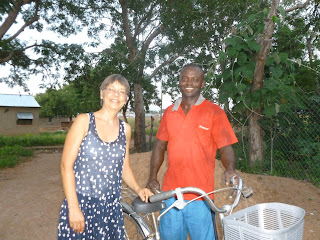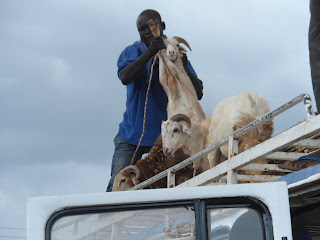………….except when one falls off!
Travel, travelling. The words conjure notions of glamour and
excitement, fed by newspapers’ colour supplements, blogs from exotic places,
endless images on Facebook and personal dreams of escape, of self-discovery, of
adventure, of renewal.
A Metro Mass Transit bus
The journey from Wa to Bolgatanga, across northern Ghana, a
distance of some 125 miles, supplies a little of the above.
 |
| A Metro Mass Transit bus |
A Monday before dawn.
It is still pouring with rain, though the thunder storm has passed. I rise at
3.30 am to be ready for the taxi taking me to the bus park. On arriving, the
driver checks where I am to wait: a concrete shelter housing sleeping bundles
of cloth amid a muddy red dirt roadway.
By 4am, stall holders are appearing. Sheltering from the
downpour under a MTN Mobile Phone sun umbrella, a woman kindles a fire, adding
broken pieces of polystyrene for good measure. The wakening passengers shift to
avoid the sickly smoke. Ready prepared porridge, brought in a recycled Dulux
paint bucket, is poured into a cauldron suspended over the flames. My choice of
breakfast will be “Egg bread”: an omelette seasoned and spiced with fresh
tomato quickly fried over charcoal, then sandwiched between a soft baton of
bread, split and toasted in the same pan, then slid into a small plastic bag.
The bus conductor appears- identified simply by a shoulder
bag and small booklet with numbered tickets. With patience and politeness, we wait in the
rain. “Who is last?” announces a new arrival, checking where to join the queue.
Slowly the bus fills with people and luggage.
At 5.50 am the bus
lurches out of the bus park. With 5 seats per row, configured in threes and
twos, space is limited. I am nicely wedged between my neighbour and the window,
so every bounce is absorbed in unison, as we quietly if fitfully doze.
The road (a generous noun) quickly deteriorates from rough
tarmac to red dirt, softened and yielding after a night’s rain, doubling as a
temporary stream bed with freshly scoured potholes. The bus creaks like a ship
as it climbs over and around each obstacle, with a triumphant acceleration into
third gear as a firmer smoother stretch of road is reached. The trip to
Bolgatanga, with one break, otherwise stopping only to pick up and drop off
passengers, should take about 9 hours, giving an average speed of 14 miles per
hour, which is about the pace of an urban bus route in the UK.
However, this journey was destined to take all day and more.
A sudden bang, the bus shifts to one side, and I glance through a mud smeared
window to see a wheel rolling away from us. As the driver and conductor
struggle to raise the bus and begin repairs they cannot complete, passengers are
urged to “walk on ahead to the next village for refreshments.” Ha! Men crowd around
the slumped bus, offering advice, mothers let toddlers run into the grass. I fall
into conversation with a young teacher, Michael. We soon decide to follow
others in straggling twos and threes along the road, as
though to walk to Bolgatanga.
Eventually it is our turn to be offered a lift by a passing
vehicle, one coming along every five minutes or so. After half an hour we pass
the first village with the promised refreshments: the “No sweat, No joy” drink
spot- closed, a covered stall with fresh local fruits and vegetables, the
beaming smiles of candidates for the forthcoming general election plastered
across walls and wandering domesticated goats, hens, sheep, cows and donkeys
everywhere. After another hour, the replacement bus from Bolgatanga, heading to
collect the driver, conductor and remnant passengers rattles past. Michael and
I talk of education systems, taxation, religion, main political parties,
housing and the differences between rural and urban living.
Ten and a half hours after setting off from Wa, we arrive in
Bolgatanga and Michael makes sure I find my bus for the onward journey back to
Zebilla, before we shake hands, exchange best wishes and he disappears into the
busy crowd to complete his route home to Kongo.
In total, my journey takes fifteen exhausting
hours. I try, like the people of Ghana do, to accept the immediate situation. I
see that any chance is taken for conversation, for extending the hand of friendship;
the funny side of a situation is shared with a full bellied laugh








































